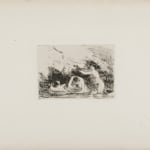Camille Pissarro (1831-1903)
Women Bathing in the Shade of Wooded Banks (Baigneuses à L’Ombre des Berges Boisees), 1894
Lithograph on chine appliqué
156 x 216 mm. (6 1/8 x 8 1/2 inches)
Signed in pencil, as published in L’Estampe originale, with their blind stamp [Lugt 819], edition of 100
Delteil 142 second (final) state
Pissarro made several etchings of nudes bathing in 1894, a year he returned to lithography after a long absence. Baigneuses a L’Ombre is a wonderful example of his ability to...
Pissarro made several etchings of nudes bathing in 1894, a year he returned to lithography after a long absence. Baigneuses a L’Ombre is a wonderful example of his ability to create new techniques in printmaking; here he uses tusche (lithographic ink) diluted in benzine or ether, on a zinc plate; he also probably used a greasy crayon (the more traditional lithographic method) as well. The use of tusche is difficult – it’s hard to control. But Pissarro successfully captures the figures playing, and envelopes them in a range of light – from light grays to dark blacks. He wrote: “I have done a whole series of printed lithographic drawings in a romantic style… which seemed to me to have a rather amusing side: Baigneuses, plenty of them, in all sorts of places, in all sorts of paradises.”
In the first state the arm of the woman at the right extended rather vaguely into space; in the second state Pissarro corrected this tendency, and he also selectively lightened the plate, creating more intermediate greys, giving the composition greater structure and movement.
In the first state the arm of the woman at the right extended rather vaguely into space; in the second state Pissarro corrected this tendency, and he also selectively lightened the plate, creating more intermediate greys, giving the composition greater structure and movement.



